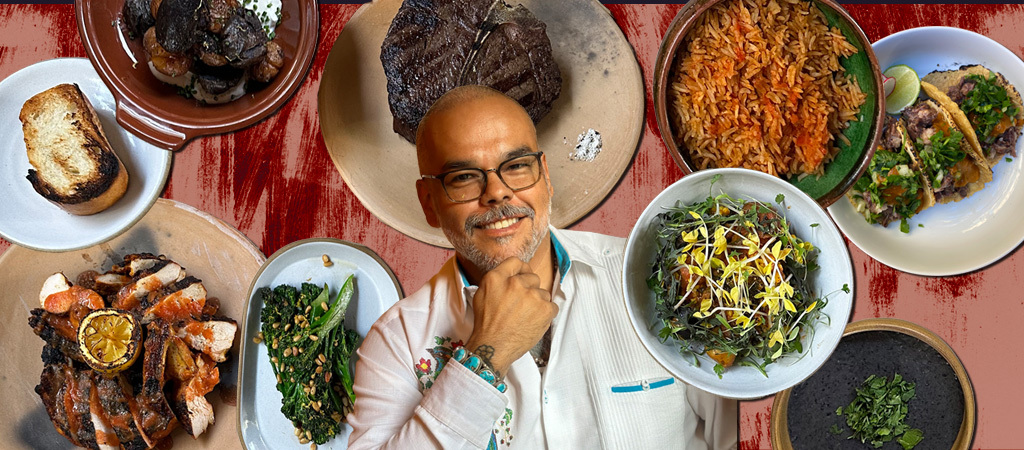The main ingredient found in all of chef Wes Avila’s cooking is his restless, creative spirit. In just over a decade, the Pico Rivera-born chef (just one town over from where I grew up) has transformed all notions of what a taco could be at Guerilla Tacos, combining ingredients like fried oysters, sweet potatoes, sushi-grade yellowtail, and other meats and veggies generally unfamiliar to the tortilla, explored the rich and ancient flavors of the Yucatan at his restaurant Ka’teen, took his unique approach to Mexican-influenced food to Kyoto, Japan with Piopiko, and created my personal favorite, the Angry Egrete Dinette, a Chinatown Los Angeles based culinary playground where the James Beard nominated chef made whatever the hell he felt like making with whatever ingredients were on hand.
Chef Avila has a habit of making an impact and then stepping away from his work to explore new passions. In 2020 he stepped down as Executive Chef at Guerilla, leaving the Arts District taqueria in the skillful hands of Chef Jason Beberman and Chef Steven Londono, and although the Angry Egrete Dinette was beloved and earned Avila a James Beard nomination for “Best New Restaurant,” the restaurant was supposed to be a three-month pop-up but ended up extending itself to a three-year project.
Avila closed AED’s doors on New Year’s Eve of last year. It’s Avila’s ability to step away and reimagine his cooking that makes him such a vital, beloved, and inspiring chef and although we miss AED, we knew it was only a matter of time before he brought us something new.
And that new something is the West Hollywood-based MXO Steakhouse, a contemporary Mexican wood-fire steakhouse inspired by the cuisine of Monterrey and infused with Avila’s own unique approach to flavor.
We caught up with the chef to talk MXO, his plans for the future, the evolution of Mexican cuisine in America, and why he’ll (probably) never create another food truck concept again.
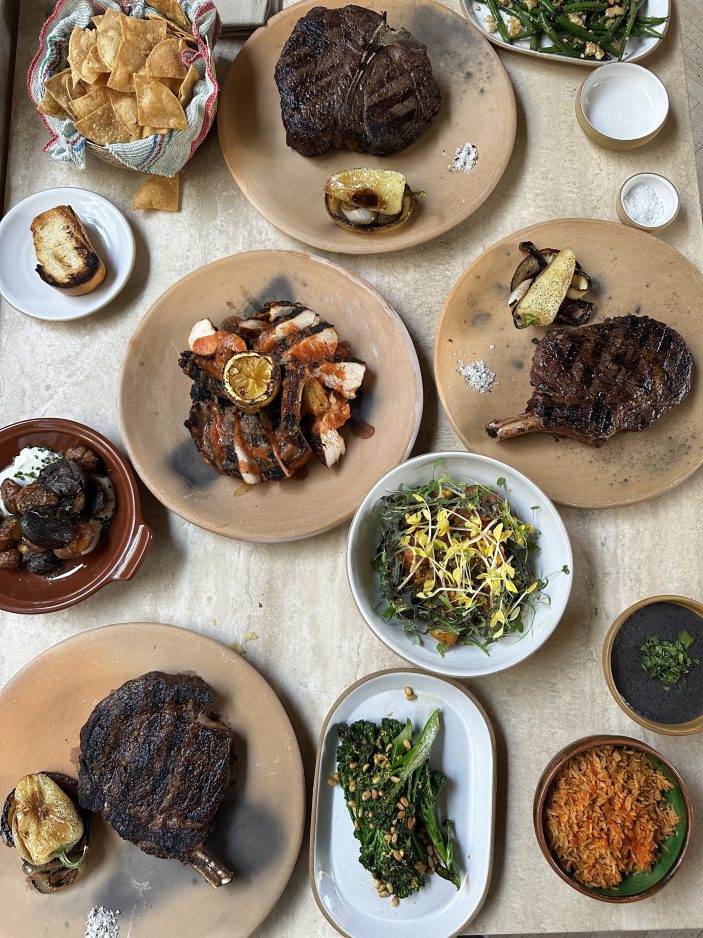
What can you tell me about this new West Hollywood joint, MXO? What was the plan going in and what has you excited about it?
The plan going in was to do something a little bit different. I had done the taqueria thing, we had done the Tulum thing, and so after visiting Monterey and some of the other northern cities, I found that there was a lack of a Mexican steakhouse in the United States and specifically in Los Angeles.
I couldn’t think of a steakhouse where you can get a good cut of steak and Mexican sides and tortillas. So I talked to my business partners about this and they were like, “let’s do it.” So we found this space with some other partners and started finishing out the build. The whole thing was to do wood fire cooking, a big focus on different steak cuts and just a good quality steakhouse with a Mexican twist, Northern Mexican twist specifically.
This is your first restaurant in West Hollywood, what made that location ideal for you?
It’s kind of two things. It fell into our perimeter that this location was available, and it was halfway built already because it had been getting built during the pandemic and then, like a lot of places, it just kind of changed. So I think ownership there had changed hands a little bit and the space was available about halfway built out, so when we jumped on it the kitchen plan was already there. Some of the infrastructure was already there, and so we took over.
And then the location is great, it being on La Cienega, it’s real central to that area. When I had my food truck, I had a stop right there off of Beverly, at the Blue Bottle. I knew the kind of clientele that would eat there and I was like, “it’d be really cool to do a space on this side of town and make it accessible to that side of town.” Because most of my other shops were on the south side, so I was really stoked to do that.
I want to talk a little bit about your restaurant Ka-Teen. The focus is on dishes from the Yucatan. What do you think people need to know about that type of cuisine and how did you get into it personally?
Just from visiting honestly, within the last, I guess, four to five years, I had been going to Tulum and Merida more than a couple of times, and it’s just something that kind of stuck with me and stood out that there hadn’t been — there’s been comida Yucateca, for sure in Los Angeles. You have every region already, but you didn’t get something specifically Tulum, like the vibes, like when you went to the beach and you’re walking and you can smell the copal and you hear the music and the jungle and along with that really good food. So that’s what got me inspired with Ka-Teen, that whole vibe.
The last two places, Ka’Teen and MXO — I mean you’ve always done very elevated food, but these are very high end spaces. Do you think you’ll ever do another street food concept?
Not specifically street food, not necessarily where I have a truck again, but I mean never say never. Never’s a long time. But I will probably be working on a fast casual concept next. Not something where it’s hardcore street style, but more kind of Egret-ish like I was doing there. It was a little bit more casual between street food and not so elevated, a little bit more approachable.
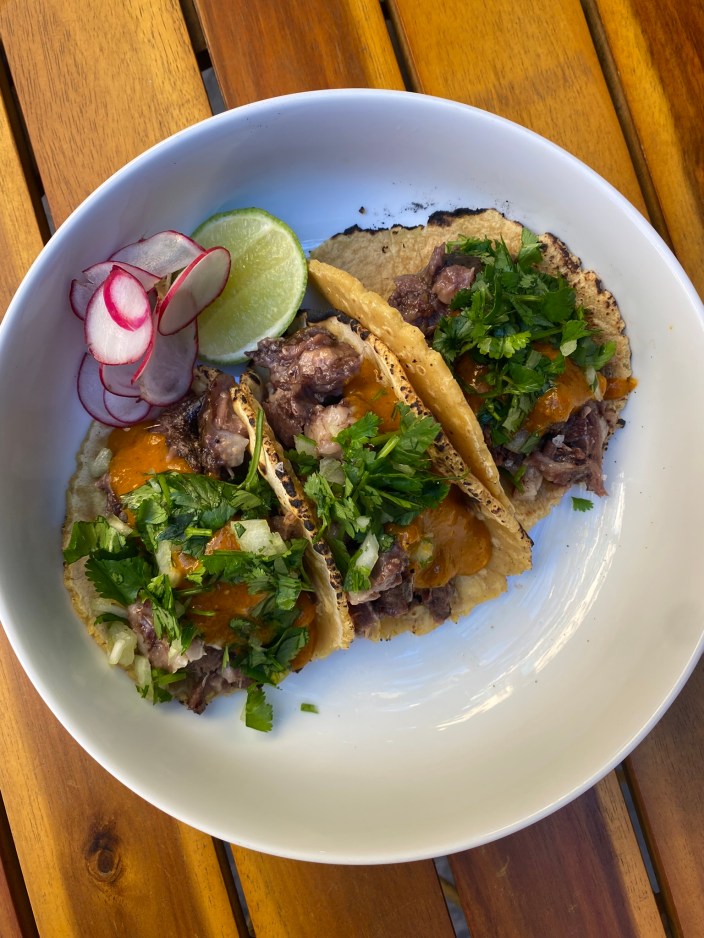
Speaking of Angry Egret, that was initially supposed to be a pop-up, if I understand that correctly, and it kind of just took off. It got a James Beard nomination. How often are people asking you to reopen it or do something similar to that?
I get emails to do ghost kitchen stuff with it pretty often actually where it’s like “Chef, you just come in, you do your couple of burritos, like the bangers.” But right now my focus is MXO, getting that locked in, dialed in. The crew’s doing a really great job already, but getting that really dialed in and getting all the bolts tightened.
After that, what I’m thinking is something kind of Egret-ish, but scalable where we can do multiple units. The thing with Egret was that it was so unique and we changed the menu so much, there’s no fucking way that I’d be able to do one here, one there, one over there with it being consistent. So I would probably distill my best ideas from Egret and distill some of my favorite stuff from Ka-Teen, more from MXO and do something a little bit more casual.
Which I can’t talk too much about the casual, the new one that I’m doing because it’s not really fleshed out quite yet.
That’s exciting either way! You have a lot of restaurants in L.A., you have the Kyoto restaurant, I know you do a lot of pop-ups worldwide. What country or city’s food space is really exciting you right now?
I mean Japan’s always number one for me, Japan’s always really exciting. I mean, Mexican food is my favorite, but vibes and energy and just where it’s like, fuck dude, there’s so much delicious food. Japan specifically in Osaka and Kyoto are popping… It’s their independent little places. It’s the mom and pop. There’s so many mom and pops there, it’s incredible.
I’m talking places that are the size of three, four seats. The restaurant is like a little bar and it’ll be packed with multiple different restaurants where you won’t even know how to get to it after you find it. It’s just so interesting to me and fascinating the amount of care that Japanese chefs and Japanese cooks put into their food that even in those little shops, you can get a really, really good meal that isn’t on anybody’s radar. You just have them find them by happenstance, just by walking.
Are you familiar with the artist Estevan Oriol?
Sure!
I was just talking to him a couple of weeks ago and we were talking about low rider culture and he brought up how the Japanese are killing it in low rider culture
For sure. They take it to the next level. I was actually speaking to a painter that I met through Instagram. I have a food truck. Funny thing, I bought it to do a food truck, but then I was like, “I don’t ever want to do a food truck again.” But it’s a really cool 1959 Dodge P300, so it’s a mail delivery van from the fifties. It doesn’t look like your typical square international food truck, those standard ones, it’s round. It’s got the flat front end, these really interesting lights, crazy bumper, and I called this painter in Salinas in northern California that does low rider, old school low rider paint, and so I’m probably going to turn into a giant low rider van.
He was telling me he’s visiting Nagoya in the winter to go paint cars because the low rider culture is so strong.
How come you don’t want to do another food truck? You feel like you’ve spent enough time in a tiny, cramped space with no air conditioning?
It’s not even the tiny space, bro. Honestly, it’s just the same amount of headache as opening a restaurant except on top of a 6,000 pound moving vehicle. It’s dangerous, there are accidents. One thing that happens with food trucks is you have the same problems you have have with a restaurant, you get floods, you have robberies, on top of that you get flat tires, you get fender benders, you get propane accidents, you get no power in your generator.
You name it, it’s multiplied. I’d say by at least five-fold the problems of a restaurant you have in a food truck. I mean the benefit there is you always have the prime location. If you’re not doing good business, a lot of times the answer is to just move. You can move two blocks. I remember when I was in the arts district and I moved two blocks over, I had guests that were like, “where’d you go? We haven’t seen you in a year.” And I was like, “dude, I’m two blocks over.” They’re like, “oh, it’s the art district. Nobody goes further than a block here, a block there.” He was right. A lot of times people just do not walk in L.A.
The good thing about the food truck is that you can move, but for me it’s so much more pressure running a food truck and unless you build out brand new ones, it’s very expensive. It’s as expensive as a restaurant. A build out on just your truck is close to $300K. Well, it was close to $300K three years ago when I was looking at it, so it might be more like $325, $350 now, it’s expensive, bro. And it takes a while to make that money back. You got to sell a lot of fucking tacos to make that kind of money. So that’s why it’s not as appealing to me.
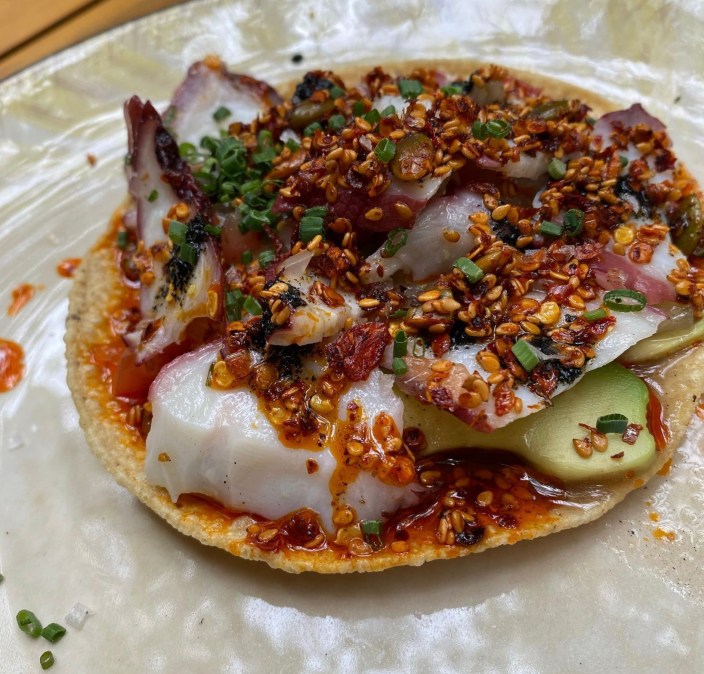
You’re one of the first people in L.A. who started to transform the idea of what a taco could be at Guerrilla Tacos. You did all kinds of crazy stuff putting all kinds of foods on tortillas that most people wouldn’t expect. What made you want to challenge the preconception of what a taco could be in America?
Honestly, it was set and setting, bro. It was something that nobody was doing on the market when I was doing it. So I kind of struck at the right time with that idea and a lot of that stuff was instilled in me as a cook and as a chef, this idea of using seasonality.
And on the street, you’re dealing directly with customers. You don’t have your chef that’s running your place. You don’t have a GM that’s running your place. You are cooking, you are serving, people are eating, they’re talking to you. So I ask, I’m like, “Hey, if I added a couple of extra ingredients from the farmer’s market, would you guys be okay if I charge the dollar or two more for the taco?” And they’re like, “fuck yeah.” So it opened up my mind. I was like, all right, fuck it.
I’m going to do pork belly, I’m going to do pig head, I’m going to do cocktails of camaron with blood clams and surf clams and all this other shit on the street and just kind of pushing myself. It honestly was kind of a guilty thing, pushing it myself. It wasn’t that I’m doing this to impress people. It was like, this is fucking good. And then after by default people were like, “this is fucking good.” So it kind worked out like that. I also think I was fortunate to be in that really early cusp of street food.
The second or third wave of food trucks had died, by that time. It was kind of like the taper end of that real second huge pop of people kind trying to copy what Kogi did years ago, years before me, so it was kind of the tail end of that.
But there was a lot of food trucks on the market and they weren’t street carts, they were pop-ups. The only pop-ups that were doing stuff like that was Ludo Bites. And it wasn’t like it is now where people set up a street cart. That just wasn’t happening. The only people doing street carts were Rasa and they were doing them for years. They’ve doing the little hot dog carts, the little dirt dogs and taquerias that you’d see. But as far as being an American born Mexican, Chicano, you didn’t see that. You didn’t see chefs doing that. You didn’t see them setting up like that. So I was, if they can do it, why can’t I? So when I got shut down by the police, they said, “where’s your permit?” I have it, but I didn’t bring it with me. They kind of rolled their eyes and they’re like, “you need to shut it down”. They know that it wasn’t legal then. This was 2012, 12 years ago. It’s a while back.
Were the tacos you were making kind of a hard sell for people just walking on the streets who maybe weren’t familiar with what you were trying to do?
Not where I was at. I was in the art district and the art district had a pretty Bohemian crowd. So you had artists, you had people who were car dudes and you had some people come through that were like truck drivers or whatever who would be doing deliveries and stop by. And they’re like, “what do you got? Do you have a thigh, you have chicken?” I was like, “nope, I got pork belly, I have short rib.” And they’re like, “that’s all right, cool. Fucking pork belly, short rib.” As long as its meat it works for most people.
And then if you can tell them what kind of cut of meat it is, they’re okay with it. It starts getting ridiculous when you start getting an $8 taco or a $9 taco or a $10 taco. At the time I’d get some pushback and I get the occasional fucking idiot. That’d be like, “I can get this for $2 up the street.” And my and my wife’s reaction would be like, “then go up the street! I don’t need your energy bro. Fuck off. There’s La Reynas up the street. Go to La Reynas. You want those ones that are like all meat, you don’t even know where comes from. Go be my guest. So they’re a dollar, two dollars. Go ahead. I have no problem losing a customer if they were being negative and weird like that.”
How do you feel about the way that Mexican food in America is undervalued?
I think honestly a lot of that’s shifting. I think it’s very true in some markets, but Los Angeles, it’s changed a lot. I mean, you’ll be hard-pressed to find a dollar taco stand. Even La Raza you won’t find it, not for a good one. You ain’t going to get no fucking dollar taco. You get places that are good Street Mexican owned, Mexican ran tacos. They’re running three bucks, four bucks now.
There’s no front end where you can find one for like a dollar now, no fuck you, where are they a dollar where are they 50 cents? You could not survive. You couldn’t make that. It doesn’t exist anymore. So I think that’s changed a lot. And the Tex-Mex thing with the rice and beans and combo it’s not really as popular anymore. That was true 15 years ago. Now it’s not as popular. You get more regionality. You get what Oaxacan restaurants, you get Teco restaurants, you get Sonoran restaurants, etc. You pick what kind of Mexican food you want now. So if somebody’s going to a Cevicheria and complain about food, that’s the one that Mexicans don’t complain about. If you’re doing raw or you’re doing seafood, they won’t complain about the price because seafood is fucking expensive and they know it.
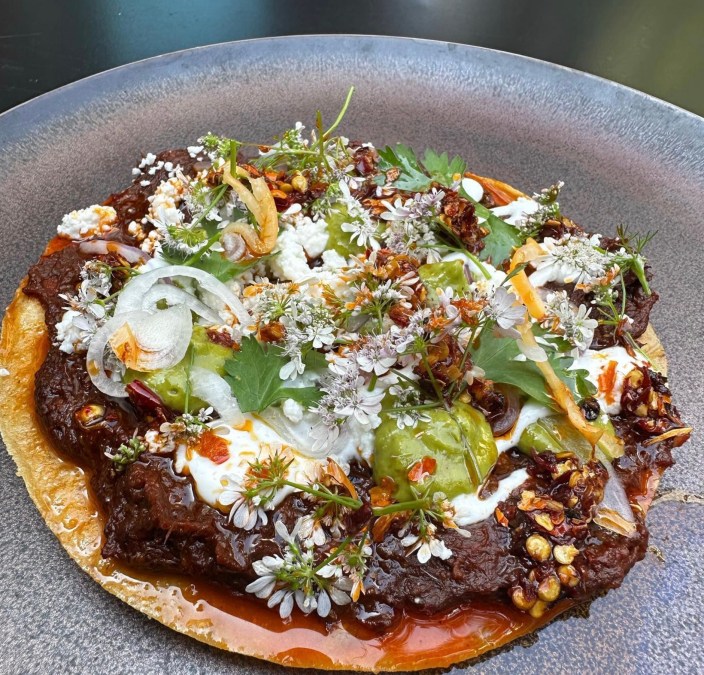
Another thing I was talking with Estevan about a lot was Chicano culture and how Chicano culture for him specifically in the nineties, was very resonant. It was very much a part of his personality. And now with the younger generations, that identity is starting to wane a little bit, starting to shift and change into something new. Do you ever feel a need to represent Chicano culture through cuisine? Or are you already doing that just by being Chicano?
I think I’m already doing that by it being a mix. My food is not straight-up Mexican, it isn’t. And I’ve never said it is. People get huffy about this, “this isn’t Sonora, this isn’t Monterey.” I never said it was, I said I was inspired by Monterey. I said I was inspired by the Yucatan. I never said this is Comida Yucateca. I never said, this is Comida teconas, I’ve never said that. I’ve always said my food is my food through my eyes being born and raised in LA of Mexican descent. You know what I mean? And that’s straight-up Chicano right there, as much as it could be.
You’ve pushed the taco, you’ve even pushed the torta. Is there any other Mexican food staple you think is due for transformation? An elevation or something you’d like to see? Not even necessarily something you want to do yourself?
I don’t know. That’s a good question. I think it’d be really cool to see a little bit more Afro Mexican cuisine. I know they exist. I know that there’s paisa out there that are half black, half brown. I think it’d be interesting to see some more representation of that kind of food. You don’t see too much of it in the United States at all, and I know it exists. I imagine it being very good. I talked to Bill Sparsan and he’s mentioned some places in Oaxaca, specifically these beach towns where there’s a much bigger population of Afro Mexicanos. And he said the food is really fucking interesting there. That’s the kind of food I want to taste next. That’s something I’d be really interested in seeing and trying, that hybrid of both cultures, especially through that eye of Southern Mexico.

